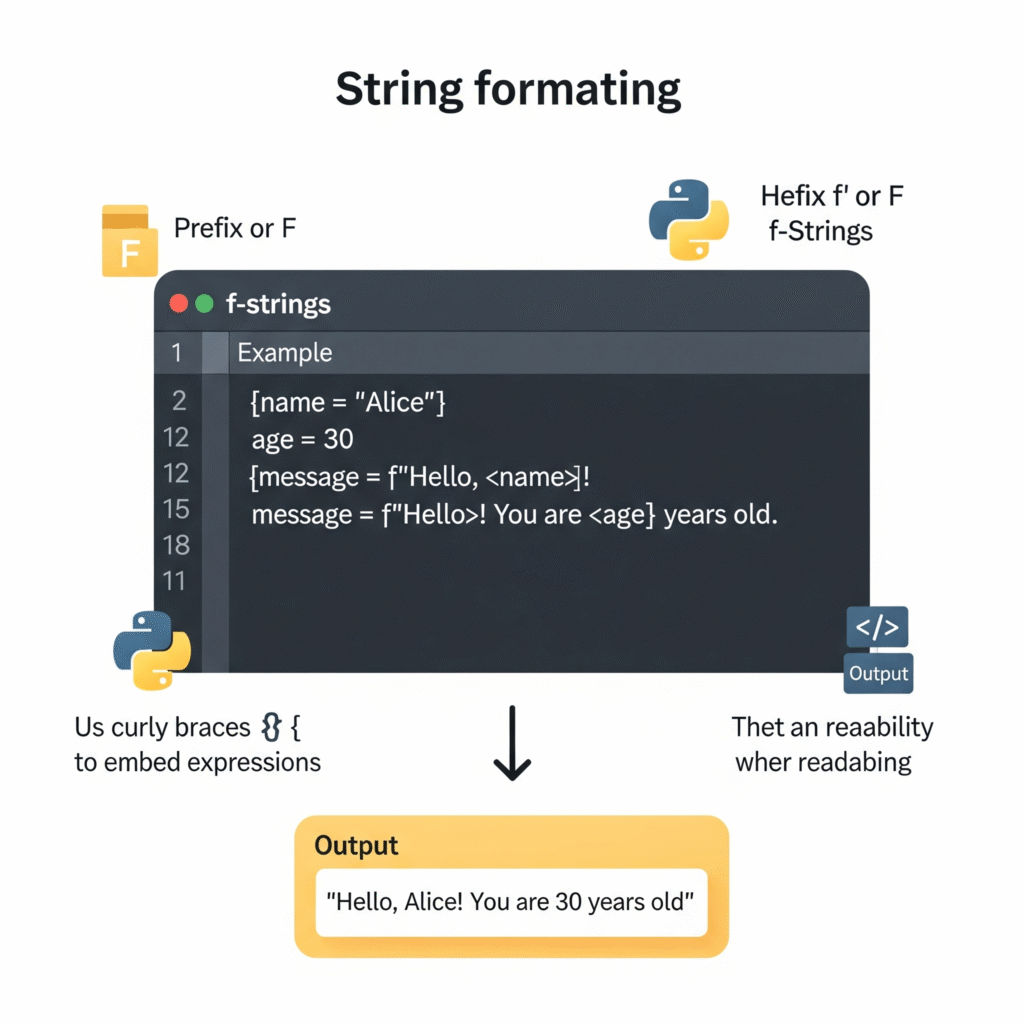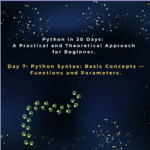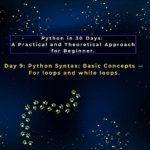Introduction
Welcome to Day 8! You’ve already learned how to create and perform basic operations on strings. Today, we’re going to take a deeper dive into Python string manipulation, a core skill that allows you to format, clean, and modify text data in your programs. Mastering these techniques is essential for tasks ranging from validating user input to parsing data from a file or the web.
You can follow along by running each code snippet in an online editor.

String Formatting: Presenting Data Clearly
String formatting allows you to embed variables and other values directly into a string. The most modern and recommended way to do this in Python is with f-strings (short for formatted string literals). F-strings are a powerful tool for Python string manipulation.
Pythonname = "John"
age = 25
# Using an f-string (modern and recommended)
formatted_string = f"My name is {name} and I am {age} years old."
print(formatted_string)
# Output: "My name is John and I am 25 years old."
# You can also use f-strings for more complex formatting, like decimal precision
pi = 3.14159
print(f"Pi to two decimal places is: {pi:.2f}")
# Output: "Pi to two decimal places is: 3.14"
# Using the .format() method (older but still common)
formatted_string2 = "My name is {} and I am {} years old.".format(name, age)
print(formatted_string2)
# Output: "My name is John and I am 25 years old."
F-strings are preferred because they are more readable, concise, and often more performant than older formatting methods like .format() or the % operator.

Checking String Properties and Cases
Python provides several built-in methods to check a string’s properties. These methods are invaluable for validating user input and for various Python string manipulation tasks.
isupper() and islower()
These methods check if all alphabetic characters in the string are uppercase or lowercase, respectively.
Pythonmy_string = "HELLO"
is_upper = my_string.isupper()
print(is_upper) # Output: True
my_string = "hello"
is_lower = my_string.islower()
print(is_lower) # Output: True
# Note: isupper() returns False if the string contains non-alphabetic characters
my_string_with_numbers = "HELLO WORLD123"
print(my_string_with_numbers.isupper()) # Output: True
isalnum(), isalpha(), isdigit()
These methods test if a string contains specific types of characters. They return True only if all characters in the string are of the specified type.
Pythonmy_string = "Hello123"
is_alnum = my_string.isalnum()
print(is_alnum) # Output: True (contains letters and digits)
alpha_string = "Hello"
is_alpha = alpha_string.isalpha()
print(is_alpha) # Output: True (only letters)
digit_string = "12345"
is_digit = digit_string.isdigit()
print(is_digit) # Output: True (only digits)
Joining and Splitting Strings
The join() Method
The join() method is a powerful and efficient way to combine a list of strings into a single string. It uses a specified separator string to join the elements. It’s an essential method for advanced Python string manipulation.
Pythonwords = ["Hello", "World", "Python"]
joined_string = " ".join(words)
print(joined_string) # Output: "Hello World Python"
You can use any separator, like a comma, a hyphen, or a new line.
Pythonlist_of_names = ["Alice", "Bob", "Charlie"]
joined_with_comma = ", ".join(list_of_names)
print(joined_with_comma) # Output: "Alice, Bob, Charlie"
# Using a new line as a separator
multiline_string = "\n".join(list_of_names)
print(multiline_string)
# Output:
# Alice
# Bob
# Charlie
The split() Method
The opposite of join(), the split() method divides a string into a list of substrings based on a separator you provide. If no separator is given, it splits the string by any whitespace.
Pythonsentence = "Hello World Python"
words_list = sentence.split(" ")
print(words_list) # Output: ['Hello', 'World', 'Python']
# Splitting on a different character
data = "apple,banana,cherry"
fruits_list = data.split(",")
print(fruits_list) # Output: ['apple', 'banana', 'cherry']
You can also specify the maximum number of splits to perform by passing a second argument.
Pythonsentence_with_limits = "one,two,three,four"
split_with_limit = sentence_with_limits.split(",", 2)
print(split_with_limit) # Output: ['one', 'two', 'three,four']
Other Useful String Methods
Here are a few other essential methods you’ll use for Python string manipulation. For a full list, refer to the official Python documentation on string methods.
.strip(),.lstrip(),.rstrip(): Return a new string with any leading or trailing whitespace removed.lstrip()removes from the left andrstrip()removes from the right..replace(old, new): Returns a new string where all occurrences of a substring have been replaced with another.
Pythonmy_text = " Hello World! "
print(f"Original: '{my_text}'")
print(f"Stripped: '{my_text.strip()}'") # Output: 'Hello World!'
my_text = "Hello World!"
new_text = my_text.replace("World", "Python")
print(new_text) # Output: Hello Python!
The replace() method can also take a third argument, count, to specify the maximum number of replacements to make.
Summary
Today, you took your knowledge of strings to the next level by learning about advanced Python string manipulation techniques. You now know how to:
- Use f-strings and other methods for powerful string formatting.
- Check a string’s properties and case using methods like
isupper()andisdigit(). - Combine and split strings using the versatile
join()andsplit()methods. - Use other essential methods like
strip()andreplace()for data cleaning and modification.
This knowledge is fundamental for working with text-based data in Python.
The journey of learning what Python is is an exciting one, and this “30 Days of Python” series is designed to be your roadmap. Happy coding!

Top System Design Interview-Design a Social Media Feed System (2025 Edition)
Overview A…
Design a URL Shortening Service
Overview We’ll…
Top 10 System Design Interview Questions (2025 Edition)
1. Design…
Top 50 Cloud Monitoring Interview Questions with Answers (2025 Edition)
Top 50…
Top 50 Monitoring Tools Interview Questions with Answers
Top-50-Monitoring-Tools-Interview-Questions-with-Answers 1….
Top 50 DevOps Interview Questions & Answers 2025
1. What…







